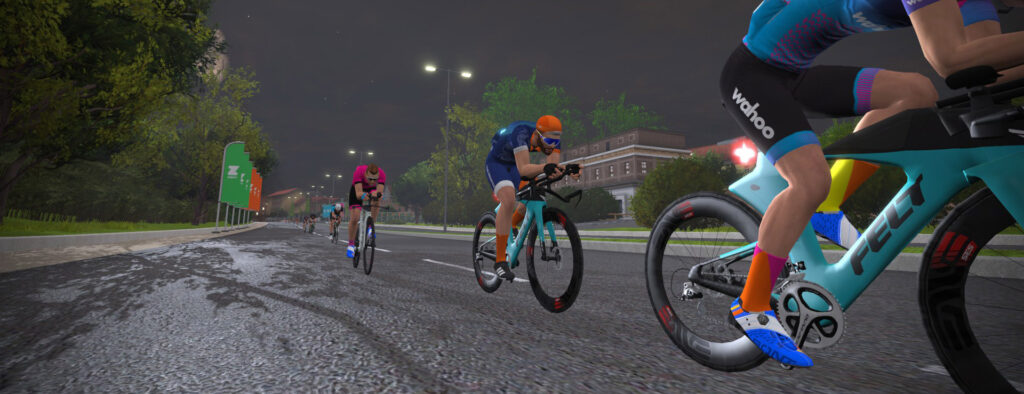A Zwifter asked me question last week: “Can you supertuck on a TT bike in Zwift?”
“You cannot,” I told him. “I’ve seen it happen occasionally as some sort of weird visual bug, but generally speaking your avatar won’t supertuck if you’re on a TT bike.”
That Zwifter went on to say they had heard rumors that you actually do receive the benefits of the supertuck on the TT bike, it’s just that the avatar animation isn’t there. Like some sort of stealth supertuck or Zwifty quantum entanglement.
Having never tested TT frames for supertucking, I decided it was worth a bit of time to get a firm answer. Especially if thousands of Zwifters will be team time trialing atop TT frames every Thursday moving forward!
Setting Up the Experiment
Testing for TT supertucking on Zwift isn’t as easy as you might think.
This is because (and few Zwifters know this) the physics of descending and supertucking are handled differently in races on Zwift than they are in every other situation. You can read all about this in our May 2019 post “All About Zwift’s Updated Race Descent Dynamics“, but to summarize:
Races
No braking force applied when coasting
Supertuck receives extra aero advantage
All Other Rides
Slight braking force applied when coasting
Supertuck simply removes that slight braking force
To supertuck in Zwift three conditions must be met:
- You must be traveling at least ~36MPH (~58km/hr)
- The gradient’s decline must be at least -3%
- Your power output must be less than 11 watts
For this experiment I used London’s Fox Hill descent. Solo riders would start the descent holding 300W until they hit 60kph, then cut their power completely (if it was a supertucking attempt) or reduce power to 50W.
Since race physics differ from free (or group) ride physics for road bikes, I figured they might for TT bikes as well. So I had to test both race events and free riding.
Speed Test Results
My riders did a total of 8 Fox Hill descents, in various configurations. We did each type of descent at both 0 watts and 50 watts. Zero watts was the supertuck attempt, while 50W was held at other times to keep riders out of the supertuck.
Here are the results (times are from Strava, so there is a bit of rounding occurring):
| Bike Type | Ride Type | Power | Descent Time |
| TT | Free ride | 0W | 2:19 |
| TT | Free ride | 50W | 2:14 |
| TT | Race | 0W | 2:18 |
| TT | Race | 50W | 2:15 |
| Road | Free ride | 0W | 2:27 |
| Road | Free ride | 50W | 2:23 |
| Road | Race | 0W | 2:08 |
| Road | Race | 50W | 2:24 |
- Note: TT bike was a Canyon Speedmax CF SLX, road bike was the Specialized Venge S-Works. Both used DT Swiss disc wheels.

Takeaways
The TT bike’s times between free riding and the race were nearly identical, which indicates that Zwift does not alter descent physics for TT frames based on the type of ride (race vs other rides).
Even though our TT supertuck attempters met all the requirements (zero watts, gradient at least -3%, going over 58kph), our avatar never supertucked visually. Moreover, the TT bike consistently turned in a faster descent time at 50 watts compared to 0 watts. Clearly there is no supertucking going on with TT frames. Not even a stealth supertuck!
This is our major takeaway for TT bike riders, regardless of whether you’re in a race or some other event: on descents, you are better off soft-pedaling at 50W than coasting. Even on steep descents! Simply put, if you’re not pedaling your TT bike, you’re losing time.
We ran the road bike tests just to confirm that Zwift’s physics are still working the way they were two years ago. And they are! The road bike’s times show that Zwift treats road frames very differently from TT frames. Supertucking on the road frame in a race was 19s faster than supertucking in a free ride!
Supertucking gives riders a major speed advantage on road bikes, but only in races. In fact, based on prior tests, we can confidently say that supertucking a steep descent in a race can give you similar speeds as riders holding 300W (4 w/kg) on that same descent.
Conversely, supertucking in a free or group ride is slower than soft pedaling at 50 watts. Keep that in mind if you’re in a non-race event and trying to go fast on a descent! Pedaling even at 50 watts will get you down the hill faster than supertucking if you’re not in a race.
Questions or Comments?
Post below!
